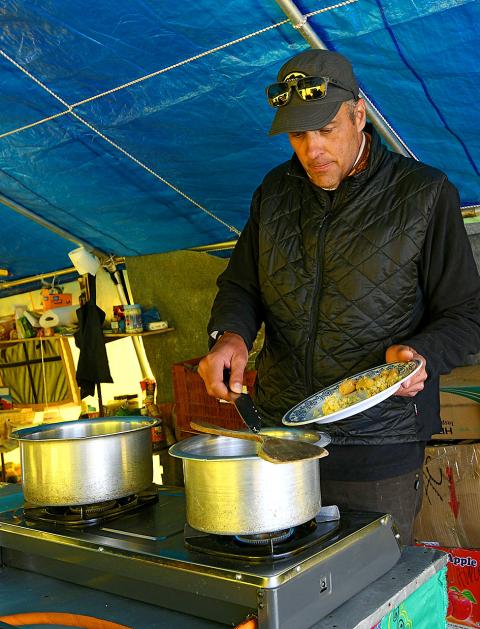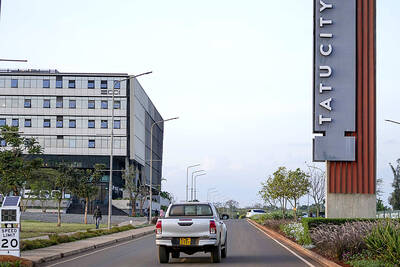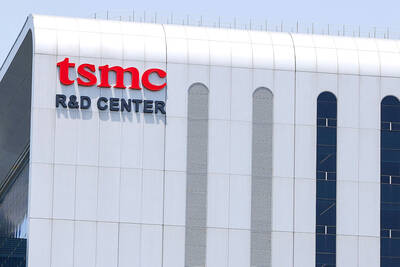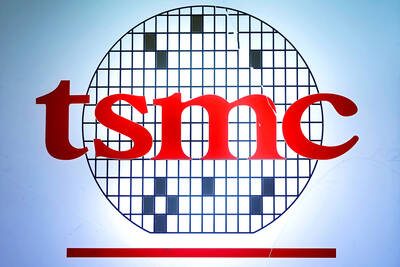Wi-Fi, baked goods and trendy coffee: Gone are the days of deprivation at Everest Base Camp, with hipster perks and modern conveniences ensuring life is cushier than ever on the roof of the world.
The Khumbu Glacier at the foot of Everest transforms every spring into a high-altitude metropolis of surprising luxury for the hundreds of climbers aiming for the peak of the world’s highest mountain.
Canned food and bulky satellite phones are a thing of the past. Today’s climbers enjoy fresh salads, Instagram and creature comforts unthinkable when Edmund Hillary and Tenzing Norgay first stood atop the 8,848m peak 65 years ago.

Photo: AFP
“The first question people ask when they arrive at Base Camp is: ‘Where’s the Wi-Fi?’’ The second question is: ‘Where’s the hot shower?’” said Everest veteran Russell Brice, owner of Himalayan Experience Ltd, one of the oldest and most established expedition operators.
The first intrepid teams to attempt Everest took a month to reach Base Camp on the Nepal side of the mountain.
The journey was cut to eight days with the construction of a small mountain airstrip at Lukla, Nepal, the gateway to the Everest region.
About 2,500 yaks make that journey at the beginning of the spring climbing season in April to turn the rock-strewn glacier into the world’s highest city for two months each year.
Tents have carpeted floors and bouquets of plastic flowers. Piping hot showers running on solar power offer respite from the freezing temperatures outside.
A brigade of helicopters keeps the tent town stocked with daily deliveries of fresh supplies to cater to the about 1,500 people at Base Camp.
Climbers who want a break from high-altitude life can even hitch a helicopter ride back to Kathmandu for some rest and recuperation before returning to attempt the summit.
At Alpine Ascents International’s camp, breakfast comes with Turkish drip coffee.
“Cappuccino machines don’t work at altitude,” director Gordon Janow said.
Meanwhile, over at Seven Summit Treks Pvt Ltd’s camp, the smell of freshly baked cinnamon rolls from its bakery greets climbers returning from an acclimatization run high on the mountain.
Fresh salads are served up by Adventure Consultants Ltd, a New Zealand-based operator, whose chef once worked in a three-Michelin-star restaurant in France.
“People seem to like simple foods. Of course, being here is so far removed from cities and normal life that basic salads and fresh vegetables seem to keep everyone happy,” chef James Perry said.
He swapped a fully equipped kitchen in an ambassador’s residence in Brussels for two gas burners and a temperamental oven at Base Camp.
“Each have their own peculiarities,” he said diplomatically, when asked who was more difficult to please: climbers or ambassadors.
Greg Vernovage of International Mountain Guides LLC, one of the largest teams on the mountain, said the modern-day perks are part of the natural “evolution” of Base Camp.
However, others lament the direction it is going.
Everyone on “the Hill” used to know one another and shared everything from radio frequencies and weather forecasts to banter over an afternoon “guides’ brew” — whiskey, honey and water, veterans said.
The village atmosphere is gone now, they said.
Base Camp is a warren of tents as more climbers than ever try to reach the top of the world.
Last year saw a record 373 permits granted to foreign climbers to venture up Everest from the Nepal side, and this year fell just shy of that.
Money has also sown division in the once close-knit community.
Crowds are growing as prices drop, with bargain operators offering cheaper — and many fear unacceptably risky — ways for glory-chasers to summit.
Foreign operators — most charging climbers about US$65,000 to reach the summit — complain that Nepalese outfits skirt safety and invite crowding by offering packages for as little as US$20,000.
Nepalese-run expedition groups have said that foreigners treat Everest like a colonial outpost and are threatened by the competition they represent.
The modern-day conveniences might make life at Base Camp easier, but reaching the summit remains as treacherous as ever.
Three climbers have died this year. Last year, six perished.
Anything that improves comfort — physically and mentally — is essential as climbers prepare to ascend to almost the cruising altitude of a jetliner, Brice said.
“The psychological impact of how people feel will impact how they perform on the mountain,” he said.

To many, Tatu City on the outskirts of Nairobi looks like a success. The first city entirely built by a private company to be operational in east Africa, with about 25,000 people living and working there, it accounts for about two-thirds of all foreign investment in Kenya. Its low-tax status has attracted more than 100 businesses including Heineken, coffee brand Dormans, and the biggest call-center and cold-chain transport firms in the region. However, to some local politicians, Tatu City has looked more like a target for extortion. A parade of governors have demanded land worth millions of dollars in exchange

An Indonesian animated movie is smashing regional box office records and could be set for wider success as it prepares to open beyond the Southeast Asian archipelago’s silver screens. Jumbo — a film based on the adventures of main character, Don, a large orphaned Indonesian boy facing bullying at school — last month became the highest-grossing Southeast Asian animated film, raking in more than US$8 million. Released at the end of March to coincide with the Eid holidays after the Islamic fasting month of Ramadan, the movie has hit 8 million ticket sales, the third-highest in Indonesian cinema history, Film

BIG BUCKS: Chairman Wei is expected to receive NT$34.12 million on a proposed NT$5 cash dividend plan, while the National Development Fund would get NT$8.27 billion Taiwan Semiconductor Manufacturing Co (TSMC, 台積電), the world’s largest contract chipmaker, yesterday announced that its board of directors approved US$15.25 billion in capital appropriations for long-term expansion to meet growing demand. The funds are to be used for installing advanced technology and packaging capacity, expanding mature and specialty technology, and constructing fabs with facility systems, TSMC said in a statement. The board also approved a proposal to distribute a NT$5 cash dividend per share, based on first-quarter earnings per share of NT$13.94, it said. That surpasses the NT$4.50 dividend for the fourth quarter of last year. TSMC has said that while it is eager

‘IMMENSE SWAY’: The top 50 companies, based on market cap, shape everything from technology to consumer trends, advisory firm Visual Capitalist said Taiwan Semiconductor Manufacturing Co (TSMC, 台積電) was ranked the 10th-most valuable company globally this year, market information advisory firm Visual Capitalist said. TSMC sat on a market cap of about US$915 billion as of Monday last week, making it the 10th-most valuable company in the world and No. 1 in Asia, the publisher said in its “50 Most Valuable Companies in the World” list. Visual Capitalist described TSMC as the world’s largest dedicated semiconductor foundry operator that rolls out chips for major tech names such as US consumer electronics brand Apple Inc, and artificial intelligence (AI) chip designers Nvidia Corp and Advanced